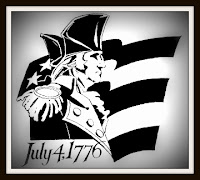Samuel Mower (my fourth great granduncle) was born 17 May 1761, in Charlton, Massachusetts. He was the fourth of ten children born to Jonathan and Elizabeth (Bemis) Mower.

In Aug 1777, at the age of 16, Samuel enlisted to fight in the "war of the revolution," joining the Company of Capt. Abijah Lamb in Col. Cushing's Regiment, for a period of 4 months. He marched to Bennington, Vermont, arriving there a few days after the Battle of Bennington (16 Aug 1777). The Company then marched to Manchester, Vermont, before continuing on to the American camp at Stillwater, New York. Samuel Mower was at the Battles of Saratoga (19 Sep1777 and 7 Oct 1777) when British General John Burgoyne was captured, and he witnessed the General surrendering his sword. The Company next marched to Albany, and thereafter Samuel was discharged about mid-December in the vicinity of New York City, having fulfilled his enlistment term. At the beginning of Apr 1778, Samuel enlisted again as a private for a period of nine months in Capt. Samuel Lamb's Company, Col. Nathaniel Wade's Regiment of the Massachusetts line. He served his term and was honorably and verbally discharged near Greenwich, Rhode Island, on 1 Jan 1779. He subsequently re-enlisted for a third term, this time for three months, to serve under Capt. Clark, stationed for much of that time in Rhode Island, where he again was verbally discharged at the end of his enlistment term. His final enlistment was in Aug 1779, when for a period of two months he enlisted in Capt. Abijah Lamb's Company, Col. Davis' Regiment, marching again to Rhode Island. His final discharge occurring after 5-6 weeks of service in this Company; Samuel having served a total of 16 months and 6 weeks fighting for the Patriotic cause.
After the war, Samuel moved to Oxford, New Hampshire, where he plied the trades of stone cutter and blacksmith. Of note, according to the
Mower Family History, Samuel furnished some of the granite that was used in the construction of Dartmouth College buildings. About 1781, he married Deidama Morey of Oxford. She was the daughter of Ephraim and Abigail (Daniels) Morey, born 20 Jul 1762. They must have returned to Charlton, Massachusetts, as the births of their first two children are recorded there. They then moved to Greene, Maine, joining Samuel's older brothers who had already journeyed north. There he continued to carry out his trade as a blacksmith, reportedly being a fine workman, as well as raise a large family. Physically, Walter Mower states in the
Mower Family History that Samuel was a man of only medium height, thick set and very muscular.
Samuel and Deidama had 11 children, all but the first two born in Greene, Maine:
- Sally, b. 10 Aug 1782
- Lewis, b. 2 Jun 1784
- Ruth, b. 28 Apr 1786
- Deidama, b. 13 May 1788
- Samuel, b. 10 Sep 1790
- Luther, b. 6 Jul 1793
- William, b. 22 Nov 1795
- Pamelia, b. 22 Oct 1797
- Mary, b. 28 Oct 1799
- Temperance, b. 5 Dec 1803
- Laura, b. 24 May 1805
In May 1818, Samuel applied to the Secretary of the Department of War of the United States for a military pension for his Revolutionary service. Sadly, the application indicates that he has reduced circumstances and is in need of the assistance of his country for support. In certifying his service, his older brothers add that Samuel's circumstances are "low by reason of a son who is now twenty two years old which is a non-compos person which has & now does cause him great expense." This would be a reference to William, who as a child had a severe epileptic episode that left him in a demented condition that he never recovered from. The cover of this pension file indicates it was rejected as Wade's Regiment was not a "Continental Establishment." He did subsequently apply for a pension under the Revolutionary Claim Act of June 7, 1832, for which he was awarded an annual pension of $57.19.

Deidama died in Greene on 23 Mar 1826. William married Mrs. Hannah (Johnson) Lord, the widow of John Lord of Gardiner, Maine, on 10 Nov 1826. Samuel died on 21 May 1847 in Greene, Maine, and is buried in Old Valley Cemetery next to his first wife. Hannah survived him, dying in Oct 1850.
Line of descent: 1-Richard Mower, 2-Samuel Mower, 3-Samuel Mower, 4-Jonathan Mower
- - - - - - - - - -
Sources available upon request.









